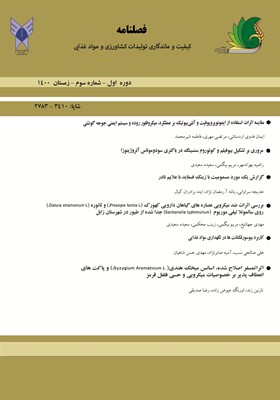گزارش یک مورد مسمومیت با زینک فسفاید با علایم نادر
محورهای موضوعی : ماندگاری فراورده های غذایی و تولیدات کشاورزیخدیجه سراوانی 1 , انته آ رمضان نژاد 2 , ایده برادران کیال 3
1 - استادیار پزشکی قانونی، گروه داخلی، دانشکده پزشکی، دانشگاه علوم پزشکی زابل، زابل، ایران
2 - استادیار، گروه داخلی، دانشکده پزشکی، دانشگاه علوم پزشکی شهرکرد، شهرکرد، ایران
3 - متخصص پزشکی قانونی و مسمومیت، سازمان پزشکی قانونی، پزشکی قانونی البرز، کرج، ایران
کلید واژه: علایم, مسمومیت, زینک فسفات,
چکیده مقاله :
زینک فسفاید یک نوع جونده کش، معمولا به صورت پودر خاکستری -سیاه رنگ است که بعلت قیمت ارزان و در دسترس بودن به صورت گسترده استفاده میشود. ممکن است به صورت تصادفی یا عمدی به قصد خودکشی یا دیگر کشی استفاده شود.مورد ما یک آقای 38 ساله بود که 3 ساعت بعد از خوردن حدود 100 گرم مرگ موش حاوی زینک فسفات به قصد خودکشی با کاهش سطح هوشیاری و سیانوزمراجعه کرده بود. علایم اولیه بیمار شامل سیانوز تهوع، استفراغ، سردرد، سرگیجه، ضعف و بی حالی، تاری دید و درد شکمی ناحیه اپیگاستر و قسمت فوقانی و راست شکم بود. در سابقه قبلی بیمار سابقه دیابت و اختلال چربی خون، هایپرتنشن، هپاتیت و سل و تالاسمی مینور و بیماری عصبی را نداشت.زینک فسفاید یک نوع مسمومیت تهدید کننده حیات است که آنتی دوت خاصی ندارد. در بیماران جوان با اسیدوز متابولیک و هایپوتنشن ناگهانی باید به مسمومیت با ترکیبات فسفاید از جمله زینک فسفاید فکر کرد . انجام یک رادیوگرافی شکمی میتواند به تشخیص زود هنگام کمک کند. درمان و احیای سریع میتواند به نجات جان بیماران کمک کند.
Zinc phosphide is a rodenticide that is commonly available as grey-black powder and is widely used due to its low cost and high availability. This rodenticide may be consumed deliberately, unintentionally, for suicide purposes, or other purposes. We report the case of a 38-year-old man, who committed suicide by consuming almost 100 grams of zinc phosphide rodenticide and experienced reduced consciousness and cyanosis. The early symptoms of cyanosis included nausea, vomiting, headache, vertigo, numbness, weakness, blurry vision, epigastric abdominal pain, and pain in the upper and right abdominal sections. The patient also had no history of diabetes mellitus, high blood cholesterol, hypertension, hepatitis, tuberculosis, minor thalassemia, and mental diseases. Zinc phosphide is a life-threatening poison with no specific antidote. Besides, phosphide poisoning including zinc phosphide poisoning must be considered in young patients suffering from sudden hypotension and metabolic acidosis, while abdominal radiography contributes to the early diagnosis of the disease. Finally, rapid recovery and treatment may save the patient’s life.
1- Haridas A, Mukker P, Hameed S, Ajith PG. Acute on chronic liver failure presen-tation of zinc phosphide poisoning: a concept elucidating case report. Intern-ational Journal of Research in Medical Sciences. 2017;4(6): 6-2494.
2- Yogendranathan N, Herath HM, Sivasu-ndaram T, Constantine R, Kulatunga A. A case report of zinc phosphide poisoning: complicated by acute renal failure and tubulo interstitial nephritis. BMC Pharm-acology and Toxicology. 2017;18(1):37.
3- Price NR, Dance SJ. Some biochemical aspects of phosphine action and resistance in three species of stored product beetles. Comparative biochemistry and physiology. Comparative pharmacology and toxicolo-gy. 1983;76(2): 81-277.
4- Ramezani Z, Babahajian A, Yousefine-jad V. Intravascular Hemolysis following Acute Zinc Phosphide Poisoning; a Case Report. Emergency. 2018;6(1).
5- Proudfoot AT. Aluminium and zinc phosphide poisoning. Clinical toxicology. 2009;47(2):89-100.
6- Sogut O, Baysal Z, Ozdemir B. Acute pulmonary edema and cardiac failure due to zinc phosphide ingestion. The Journal of emergency medicine. 2011;40(6):8-e117.
7- Sarma PS, Narula J. Acute pancreatitis due to zinc phosphide ingestion. Postgra-duate medical journal. 1996;72(846):8-237.
8- Ostadi A, Noshad H, Ghaffari AR, Banagozar A. Transient leukopenia in zinc phosphide poisoning. Journal of Clinical Research & Governance. 2014;3(1): 5-54.
9- Gökdemir MT, Kaya H, Söğüt O, Orak M, Üstündağ M, Karasu M. A rare type of suicide attempt in east Turkey: acute zinc phosphide poisoning. Journal of Academic Emergency Medicine. 2013;12(2): 9-76.
10- ZINC PHOSPHIDE-National Library of Medicine HSDB Database 2017. Available from: https://toxnet.nlm.nih.gov/ cgibin/sis/search/a?dbs+hsdb:@term+@DOCNO+1059.
11- Dogan E, Guzel A, Ciftci T, Aycan I, Celik F, Cetin B, et al. Zinc phosphide poisoning. Case reports in critical care. 2014.
12- Gunaratne WM, Wijeratne AT, Pila-pitiya SD, Siribaddana SH. A case of severe zinc phosphide poisoning. Ceylon Medical Journal. 2016;21:61(1).
13- Hassanian-Moghaddam H, Shahnazi M, Zamani N, Rahimi M, Bahrami-Motl-agh H, Amiri H. Plain abdominal radiogr-aphy: A powerful tool to prognosticate outcome in patients with zinc phosphide poisoning. Clinical radiology. 2014;69: 5-1062.
14- Trakulsrichai S, Kosanyawat N, Atiks-awedparit P, Sriapha C, Tongpoo A, Udo-msubpayakul U, Rittilert P, Wananukul W. Clinical characteristics of zinc phosphide poisoning in Thailand. Therapeutics and clinical risk management. 2017;13:335.
15- Shakoori V, Agahi M, Vasheghani-Farahani M, Marashi SM. Successful man-agement of zinc phosphide poisoning. Indian journal of critical care medicine: peer-reviewed, official publication of Ind-ian Society of Critical Care Medicine. 2016;20(6):368.
16- Zamani N, Hassanian-Moghaddam H. RE: Successful management of zinc phos-phide poisoning. Indian Journal of Critical Care Medicine. 2016;20(8).
17- Bumbrah GS, Krishan K, Kanchan T, Sharma M, Sodhi GS. Phosphide poison-ing: a review of literature. Forensic science international. 2012;214(1-3):1-6.
_||_

